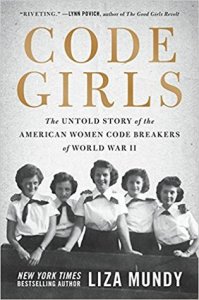Q is for Communications #AtoZChallenge
 The A to Z Challenge asks bloggers to post 26 posts, one for each letter of the English alphabet, in April. Most of us choose to make these posts on a particular theme. My theme for 2022 is Codebreaking in World War II, which fits with the topic of the novel that I’m writing. Visit every day (except Sunday) in April for a new post on my topic.
The A to Z Challenge asks bloggers to post 26 posts, one for each letter of the English alphabet, in April. Most of us choose to make these posts on a particular theme. My theme for 2022 is Codebreaking in World War II, which fits with the topic of the novel that I’m writing. Visit every day (except Sunday) in April for a new post on my topic.
Q is for Communications
 “Q for Communications” is the title of Chapter 6 in Code Girls: The Untold Story of the American Women Code Breakers of World War II by Liza Mundy.
“Q for Communications” is the title of Chapter 6 in Code Girls: The Untold Story of the American Women Code Breakers of World War II by Liza Mundy.
Chapter Six is about the Naval Communications Annex, the Navy’s answer to Arlington Hall.
When the Navy’s code-breaking operation grew too large for its quarters, they bought their own women’s junior college in a prestigious part of northwest Washington, DC. Mount Vernon Seminary was more rigorous and better connected than Arlington Hall where the Army moved their code-breaking operation.
Unlike the Army’s operation, where many women served as civilians, nearly all women codebreakers in the Navy were enlisted as Women Accepted for Volunteer Emergency Service. The cover of Code Girls shows a picture of WAVES in uniform.
Here’s the story of Q from Code Girls:
The enlisted women were given a naval rating, Specialist Q, which was inscribed on a patch. The Q did not stand for anything, but it did arouse a lot of curiosity. One day, Jane Case, the former debutante, was walking up Wisconsin Avenue when a car stopped and offered a ride. The wartime rule was that cars should pick up members of the military. It was pouring rain and Jane accepted, gratefully, and clambered into the back. The driver was a man wearing a raincoat, and his wife was sitting beside him. During the ride up Wisconsin, he grilled Jane, asking her what went on in the communications annex and what she was doing for the Navy.
She replied with the answer she always had ready. “I fill inkwells and sharpen pencils and give people what they need,” she told him.
“What does Q in Specialist Q stand for?” he asked her.
Jane laughed it off. “It’s Q for communications; you know, the Navy can’t spell,” she said flippantly.
When they got to the barracks and the driver reached across and opened the back door to let her out, the sleeve of his raincoat hiked up slightly. She saw one gold stripe, and then several more. She realized the driver was a Navy admiral. He gave her a faint, knowing smile. He had been testing her. She had passed. (pp. 179-80)

Haha! That is great. You see a lot of “dodges” on Q day, but yours is perfect really. Use of the letter AND within your theme. Been following (but not always posting) all month. I think I need to add this book to my reading list.
Thanks!
—
Tim Brannan
The Other Side | The A to Z of Conspiracy Theories
Oooh, now there’s a cool story!
The Multicolored Diary
I LOVE this story.